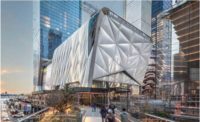How do you guide museum visitors through the unseen world of sound? That was the dilemma faced by the designers and builders of the new $125-million Musical Instrument Museum in Phoenix, scheduled to open this spring.



Featuring both historic and contemporary instruments from around the globe, the museum aims to help visitors better understand musical expression in different cultures and in various aspects of life. Bob Ulrich, former CEO of the Target Corp., is the museum’s founder and chairman; the international retailer also contributed money and services to the project.
“There’s nothing like it in the world,” says project designer Rich Varda, FAIA, who is also Target’s vice president for store design. “Bob felt this museum would be an important contribution as a cultural institution, and a great addition to Phoenix.”
Adding to the challenge of forging a new museum was the speed in which it happened. “Our main benefactor [Ulrich] is known for wanting things done fast,” Varda notes. The project broke ground in April 2008 and was recently completed; however, it won’t open its doors until April to allow time for staffing, preparing artifacts, and arranging exhibits.
Contextual Design
The design was largely driven by function, with a nod to the building’s natural surroundings. “We thought the museum scale should be broken down into smaller components and the massing should be sympathetic to the geology we see in the Arizona landscape,” Varda explains. Certain elements evoke the bluffs common in the Sonoran Desert. The metaphor is further enhanced by the use of exterior materials such as gold-hued limestone and gray-green stucco.
Masonry and steel with metal joist and deck form the building’s one-story areas, while the two-story gallery components are framed with heavy concrete to minimize sound and vibration from a busy traffic intersection nearby.
While the project won’t be submitted for LEED certification, sustainable aspects include the use of fly ash in the concrete; 25,000 square feet of photovoltaic solar panels on the second-story roof areas; a chemical-free chiller water system; and extensive xeriscaping.
Protecting the Instruments
Retaining moisture was a central concern due to the sensitivity of the antique instruments, many of them made of wood. “Typically, you are trying to keep moisture from the outside getting in, but here we are trying to keep it from going out because we want the controlled atmosphere,” says Joe Schmid, senior project manager with general contractor Ryan Cos.
For all of the interior spaces, a 15-mm polyethylene multicore vapor barrier was placed between the sub-base and the slab-on-grade concrete. In addition, a trowel- and spray-on membrane wraps the vertical exterior walls and intersects with a roof membrane. These efforts sustain humidity at an ideal 40 to 50 percent.
The design also called for a rain-screen façade. “It’s a fairly new type of construction in the U.S. where you provide an air gap between the cladding and the actual moisture protection of the building to screen it,” says Rafael Olabarrieta, associate with the local firm RSP Architects, the project’s architect of record. “It also helps equalize the pressure between the exterior of the building and the interior.” The screen is composed of a 2-inch-thick limestone panel façade secured with anchor bolts to allow for a 2-inch air gap and 4 inches of insulation.
Fluid Layout
The exhibit plan had to be flexible. The building is organized around a meandering two-story central circulation corridor dubbed El Rio. This main spine will provide a quick and easy navigation route for guests while also affording views of exterior courtyards and the surrounding desert.
Special and traveling exhibitions will be located on the ground floor; the second floor will house galleries themed around geographic areas. Other amenities accessed off this central spine include a cafeteria/coffee shop, gift shop, family center, and a 299-seat performance space.
Architectural details are inspired by musical patterns, rhythms and notation, but “we kept it fairly abstract,” Varda says. “We didn’t want it to get too literal but I think people will get the idea as they walk through the building.”






Post a comment to this article
Report Abusive Comment